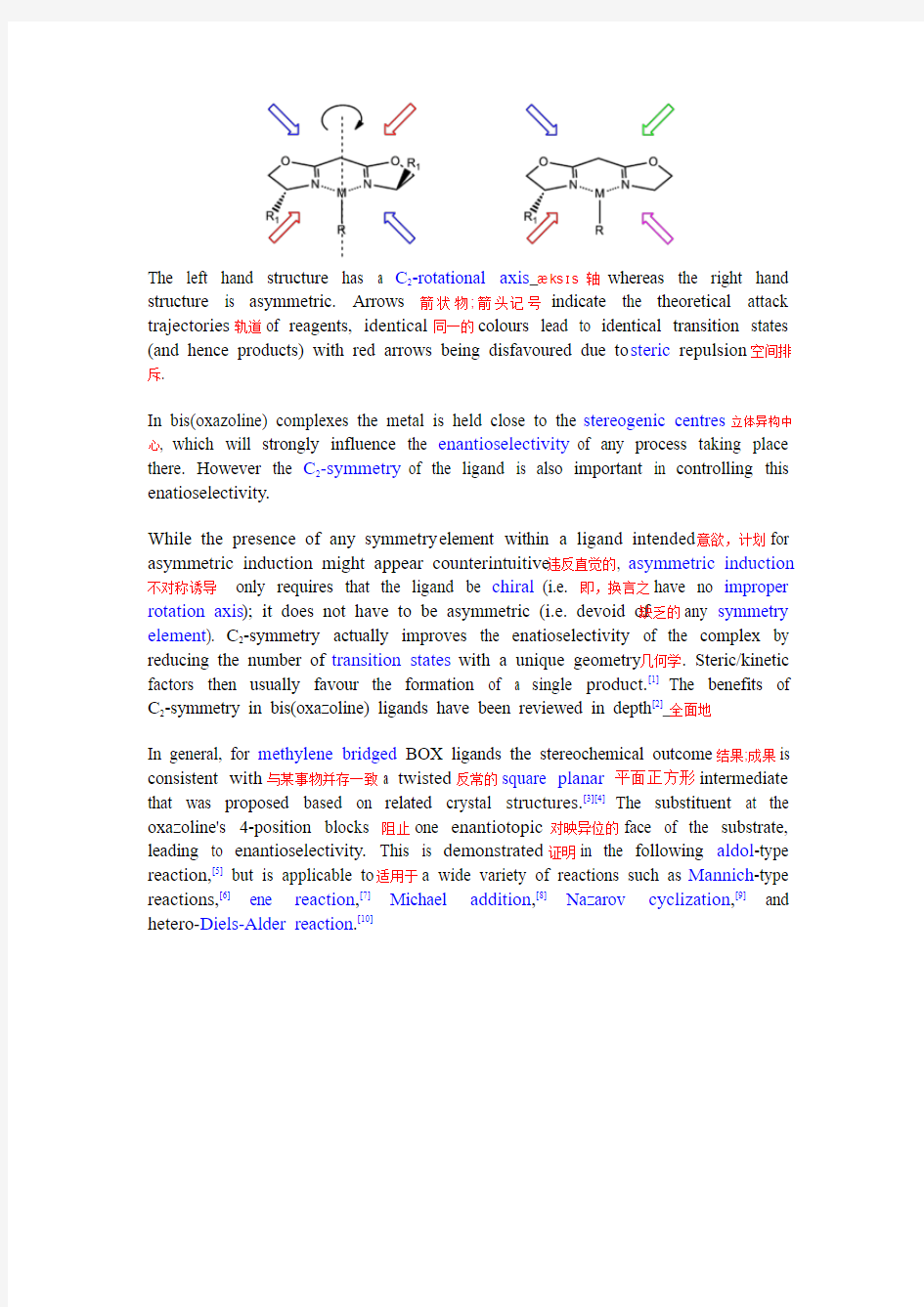配体 双恶唑啉


In chemistry, bis(oxazoline) ligands双恶唑啉配体(often abbreviated BOX ligands) are a class of privileged特许的,专用的chiral ligands containing two oxazoline rings.
-symmetric对称and exist in a wide variety of forms; with They are typically C
2
or pyridine linkers being particularly common (often structures based around CH
2
generalised概括,归纳BOX and PyBOX respectively). The coordination complexes of bis(oxazoline) ligands are used extensively in asymmetric catalysis.
Synthesis
Further information: Synthesis of oxazoline rings
The synthesis of oxazoline rings is well established and in general proceeded via the cyclisation of a 2-amino alcohol with any of a number of suitable functional groups. In the case of bis(oxazoline)s, synthesis is most conveniently achieved by using bi-functional starting materials; as this allows both rings to be produced at once. Of the materials suitable, di carboxylic or di nitrile compounds are the most commonly available and hence the majority多数bis(oxazoline) ligands are produced from these materials.
Part of the success of the BOX and PyBOX motifs动机;基本图案lies in 在于;位于their convenient one step synthesis from malononitrile丙二氰and dipicolinic acid, which are commercially available at low expense. Chirality is introduced with the amino alcohols, as these are prepared from amino acids and hence are chiral (e.g. valinol).
The advantages C2-symmetry
-rotational axis?ks?s轴whereas the right hand The left hand structure has a C
2
structure is asymmetric. Arrows 箭状物;箭头记号indicate the theoretical attack trajectories轨道of reagents, identical同一的colours lead to identical transition states (and hence products) with red arrows being disfavoured due to steric repulsion空间排斥.
In bis(oxazoline) complexes the metal is held close to the stereogenic centres立体异构中心, which will strongly influence the enantioselectivity of any process taking place
-symmetry of the ligand is also important in controlling this there. However the C
2
enatioselectivity.
While the presence of any symmetry element within a ligand intended意欲,计划for asymmetric induction might appear counterintuitive违反直觉的, asymmetric induction 不对称诱导only requires that the ligand be chiral(i.e. 即,换言之have no improper rotation axis); it does not have to be asymmetric (i.e. devoid of缺乏的any symmetry element). C
-symmetry actually improves the enatioselectivity of the complex by
2
reducing the number of transition states with a unique geometry几何学. Steric/kinetic factors then usually favour the formation of a single product.[1]The benefits of -symmetry in bis(oxazoline) ligands have been reviewed in depth[2]全面地
C
2
In general, for methylene bridged BOX ligands the stereochemical outcome结果;成果is consistent with与某事物并存一致a twisted反常的square planar平面正方形intermediate that was proposed based on related crystal structures.[3][4]The substituent at the oxazoline's 4-position blocks 阻止one enantiotopic对映异位的face of the substrate, leading to enantioselectivity. This is demonstrated证明in the following aldol-type reaction,[5] but is applicable to适用于a wide variety of reactions such as Mannich-type reactions,[6]ene reaction,[7]Michael addition,[8]Nazarov cyclization,[9]and hetero-Diels-Alder reaction.[10]
On the other hand, two-point binding on a Lewis acid bearing the meridially顶点tridentate有三齿的PyBOX ligand would result in a square pyramidal四方锥complex.
A study using (benzyloxy)acetaldehyde as the electrophile showed that the stereochemical outcome is consistent with the carbonyl oxygen binding equatorially 赤道的and the ether oxygen binding axially.[11]
Catalytic applications
Metal complexes incorporating包含bis(oxazoline) ligands are effective for an wide range of asymmetric catalytic transformations and have been the subject主题,话题of numerous literature reviews.[12][13][14]The neutral character of bis(oxazoline)s makes them well suited to use with noble metals贵金属, with copper complexes being particularly common.[13] Their most important and commonly used applications are in carbon–carbon bond forming reactions.
Carbon–carbon bond forming reactions
bis(oxazoline) ligands have been found to be effective for a range of asymmetric cycloaddition reactions, this began with the very first application of BOX ligands in
carbenoid cyclopropanations[15]and has been expanded to include 1,3-Dipolar cycloaddition and Diels-Alder reactions. Bisoxazoline ligands have also been found to be effective for Aldol, Michael and Ene reactions, amongst处在…中many others
Evans 1997:[16]BOX assisted
Aldol reaction
Aggarwal人名1998:[17]BOX assisted Diels-Alder
reaction resulting in verbenone马鞭烯酮synthesis. The
final conversion with diphenylphosphoryl azide
involves a modified Curtius rearrangement
Other reactions
The success of bis(oxazoline) ligands for carbenoid cyclopropanations led to their application for aziridination氮杂环丙化反应. Another common reaction is hydrosilylation氢化硅烷化, which dates back to the first use of PyBOX ligands.[18] Other niche合适的位置(工作等);有利可图的缺口,商机applications include as fluorination catalysts[19] and for Wacker-type cyclisations.[20]
Nishiyama 1989:[18] Enantioselective hydrosilylation
铑
